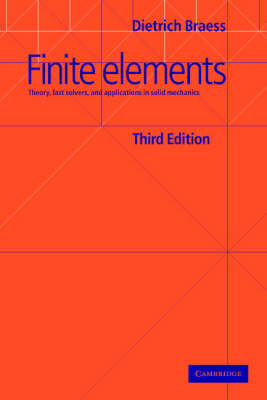
Finite Elements
Theory, Fast Solvers, and Applications in Solid Mechanics
Seiten
2007
|
3rd Revised edition
Cambridge University Press (Verlag)
978-0-521-70518-9 (ISBN)
Cambridge University Press (Verlag)
978-0-521-70518-9 (ISBN)
This definitive introduction to finite element methods was thoroughly updated for this 2007 third edition, which features important new material for both research and application of the finite element method. Graduate students who require an introduction to finite element methods will find this text invaluable.
This definitive introduction to finite element methods was thoroughly updated for this 2007 third edition, which features important material for both research and application of the finite element method. The discussion of saddle-point problems is a highlight of the book and has been elaborated to include many more nonstandard applications. The chapter on applications in elasticity now contains a complete discussion of locking phenomena. The numerical solution of elliptic partial differential equations is an important application of finite elements and the author discusses this subject comprehensively. These equations are treated as variational problems for which the Sobolev spaces are the right framework. Graduate students who do not necessarily have any particular background in differential equations, but require an introduction to finite element methods will find this text invaluable. Specifically, the chapter on finite elements in solid mechanics provides a bridge between mathematics and engineering.
This definitive introduction to finite element methods was thoroughly updated for this 2007 third edition, which features important material for both research and application of the finite element method. The discussion of saddle-point problems is a highlight of the book and has been elaborated to include many more nonstandard applications. The chapter on applications in elasticity now contains a complete discussion of locking phenomena. The numerical solution of elliptic partial differential equations is an important application of finite elements and the author discusses this subject comprehensively. These equations are treated as variational problems for which the Sobolev spaces are the right framework. Graduate students who do not necessarily have any particular background in differential equations, but require an introduction to finite element methods will find this text invaluable. Specifically, the chapter on finite elements in solid mechanics provides a bridge between mathematics and engineering.
Dietrich Braess is Professor of Mathematics at Ruhr University Bochum, Germany.
Preface to the third English edition; Preface to the first English edition; Preface to the German edition; Notation; 1. Introduction; 2. Conforming finite elements; 3. Nonconforming and other methods; 4. The conjugate gradient method; 5. Multigrid methods; 6. Finite elements in solid mechanics; References; Index.
| Erscheint lt. Verlag | 12.4.2007 |
|---|---|
| Zusatzinfo | Worked examples or Exercises; 9 Tables, unspecified; 64 Line drawings, unspecified |
| Verlagsort | Cambridge |
| Sprache | englisch |
| Maße | 152 x 229 mm |
| Gewicht | 560 g |
| Themenwelt | Mathematik / Informatik ► Mathematik ► Analysis |
| ISBN-10 | 0-521-70518-5 / 0521705185 |
| ISBN-13 | 978-0-521-70518-9 / 9780521705189 |
| Zustand | Neuware |
| Haben Sie eine Frage zum Produkt? |
Mehr entdecken
aus dem Bereich
aus dem Bereich
Band 5: Hydraulik, Stromfadentheorie, Wellentheorie, Gasdynamik
Buch | Softcover (2024)
De Gruyter Oldenbourg (Verlag)
59,95 €


